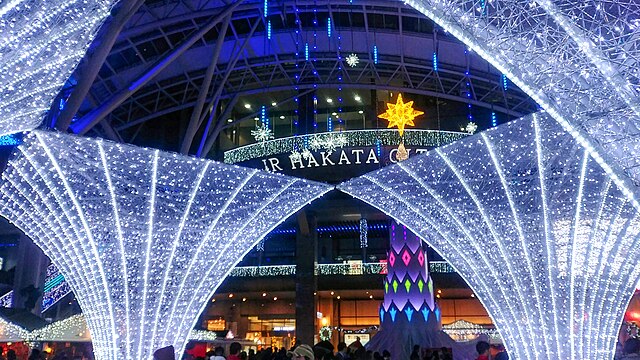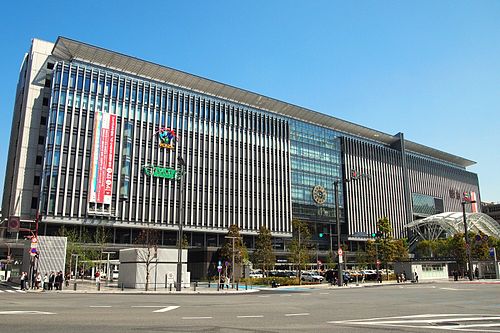Top Qs
Timeline
Chat
Perspective
Hakata Station
Major railway and metro station in Fukuoka, Japan From Wikipedia, the free encyclopedia
Remove ads
Hakata Station (博多駅, Hakata-eki) is a major railway station in Hakata-ku, Fukuoka, Japan. It is the largest and busiest railway terminal in Kyushu, and is a gateway to other cities in Kyushu for travelers coming from Honshu by rail travel. The San'yō Shinkansen from Osaka ends at this station.
This article needs additional citations for verification. (June 2007) |

The station was rebuilt in 2011. The main building was demolished and a new, larger station building, as well as office buildings and new platforms, was constructed. The station reconstruction project was initiated specifically for the Kyushu Shinkansen extension from Hakata to Shin-Yatsushiro Station which continues southward through its existing route to Kagoshima-Chūō Station. The new station building has a Hankyu Department Store, its first branch store in Kyushu, as a tenant, as well as other first-in-Kyushu branch retailers including Tokyu Hands.
Remove ads
Lines



Platforms
Summarize
Perspective
JR
| 1 | ■ Limited Express Kirameki | for Kokura and Mojikō |
| ■ Limited Express Ariake | for Yoshizuka | |
| Kagoshima Main Line | for Kashii, Orio, Kokura, and Mojikō | |
| 2 | ■ Limited Express Sonic, Nichirin | for Kokura, Yanagigaura, Ōita, Saiki, and Miyazaki |
| ■ Limited Express Kirameki | for Kokura and Mojikō | |
| Kagoshima Main Line | for Kashii, Orio, Kokura, and Mojikō | |
| 3 | ■ Limited Express Kamome, Midori, Huis Ten Bosch | for Saga, Nagasaki, Sasebo, Huis Ten Bosch |
| ■ Limited Express Kirameki | for Kokura, and Mojikō | |
| Kagoshima Main Line | for Kashii, Orio, Kokura, and Mojikō | |
| 4 | ■ Limited Express Kamome, Midori | for Saga, Nagasaki, and Sasebo |
| Kagoshima Main Line | for Kashii, Orio, Kokura, and Mojikō | |
| 5 | ■ Limited Express Ariake | for Nagasu, and Kumamoto |
| ■ Limited Express Yufuin-no-mori | for Hita, Yufuin, and Ōita | |
| Kagoshima Main Line | for Futsukaichi, Tosu, Kurume, and Ōmuta | |
| Kagoshima Main Line | for Kashii, Orio, Kokura, and Mojikō | |
| 6 | for Nagasu, and Kumamoto | |
| Kagoshima Main Line | for Futsukaichi, Tosu, Kurume, and Ōmuta | |
| 7 | Kagoshima Main Line | for Futsukaichi, Tosu, Kurume, and Ōmuta |
| Fukuhoku-yutaka Line | for Shin-Iizuka, Nōgata, and Orio | |
| ■ Limited Express Kaiō | for Shin-Iizuka and Nōgata | |
| 8 | Fukuhoku-yutaka Line | for Shin-Iizuka, Nōgata, and Orio |
| 11 | for Kumamoto and Kagoshima-Chūō (Used for first departures) | |
| 12-14 | for Hiroshima, Okayama, Shin-Ōsaka, and Tokyo | |
| 15-16 | for Kumamoto and Kagoshima-Chūō | |
| Hakataminami Line | for Hakataminami |
Fukuoka City Subway
The subway station's symbol mark is a bolt of cloth with the traditional hakata-ori pattern "Kenjō Hakata"(献上博多). Hakata-ori is a traditional woven silk textile of Hakata.
| 1 | for Fukuokakūkō | |
| 2 | for Tenjin, Meinohama, Chikuzen-Maebaru and Karatsu |
| 3 | for Hashimoto | |
| 4 | for Hashimoto |
- Entrance No.13
- Concourse
- Station sign of the Hakata subway station for Gion bound trains
- Platform
Remove ads
History
This section needs additional citations for verification. (December 2022) |
You can help expand this article with text translated from the corresponding article in Japanese. (November 2019) Click [show] for important translation instructions.
|

- 11 December 1889: opened. The original station building was about 600 m north of the current position.
- 1 December 1963: station reconstructed in present form raised above street level.
- 10 March 1975: San'yō Shinkansen services began.
- 22 March 1983: temporary Fukuoka City Subway station opened.
- 3 March 1985: current Fukuoka City Subway station opened.
- 3 March 2011: JR Hakata City opened.
- 12 March 2011: Kyushu Shinkansen services begin.
- 27 March 2023: Extension of the Fukuoka City Subway Nanakuma Line begins operation.[1][2]
Passenger statistics
In fiscal 2016, the station was used by an average of 121,370 passengers daily (boarding passengers only), and it ranked 1st among the busiest stations of JR Kyushu.[3]
See also
References
External links
Wikiwand - on
Seamless Wikipedia browsing. On steroids.
Remove ads









